
¸¶ÀÌŬ ±â¾î¼¾(Michael Geertsen)Àº µ§¸¶Å© µðÀÚÀÎ ½ºÄð(Danish Design School) Ãâ½Å µµ¿¹ÀÛ°¡·Î ÀüÅë ¹°·¹±â¹ý°ú µµÀÚ µðÀÚÀÎÀ» ¼öÇÐÇÏ¿´´Ù. ¹«¾ùº¸´Ùµµ ±×´Â Àηù¿ª»çÇÐ ÇлýÀ̱⵵ ÇÏ¿´´Ù. ¡°¿ª»ç´Â ³ªÀÇ ÀÛ¾÷ Àü¹Ý¿¡ Áß¿äÇÑ ¿ªÇÒÀ» ÇÑ´Ù. ¿ª»çÀÇ °¡¸£Ä§À» ÀÌÇØÇÏ´Â °ÍÀº ³ªÀÇ ÀÛ¾÷¿¡ ÇʼöÀûÀÎ ¿ä¼ÒÀÌ´Ù.¡± ¶ó°í ±×´Â ¸»ÇÏ°í ÀÖ´Ù.
Danish ceramist Michael Geertsen is yet another mover and shaker from the renowned Danish Design School. He trained as a traditional wheel-based potter and ceramic designer. Above all, however, he is a student of human history. ¡°History plays an important role in my entire approach to art. Understanding the lessons of history is integral to my art.¡±
ÀÛÇ° ¼Ó ¿ä¼ÒµéÀº ¹°·¹·Î Á¦À۵ȴÙ. ³ª´Â ±× ¿ä¼ÒµéÀ» °áÇÕÇÏ¿© ÀÛÇ°À» ¿Ï¼ºÇÑ´Ù. ³ª´Â ¸íÈ®ÇÑ ÄÁ¼ÁÀ» °¡Áö°í ÀÛ¾÷À» ½ÃÀÛÇϸç, ÁïÈïÀûÀÎ °ÍÀº Ç×»ó ³» ÀÛ¾÷¹æ½ÄÀÇ ÀϺÎÀÌ´Ù. ³ª´Â ÄÅ, Á¢½Ã, ȺÐ, Â÷ÁÖÀüÀÚ¿Í °°ÀÌ ¸ÅÀÏ ¾²ÀÌ´Â »ýÈ°µµÀÚ ¿ä¼ÒµéÀ» ÇØüÁÖÀÇÀû Á¢±ÙÀ» ÅëÇÏ¿© ¿ì¸® ÀÏ»ó»ýÈ°À» ÃÊ¿ùÇÏ´Â, Áï ¿¾ ¿ª»ç¸¦ ÀǹÌÇÏ´Â µ¿Áö¿¡ ¾ÕÀ¸·ÎÀÇ »õ ÀåÀ¸·Î ³ª¾Æ°¥ ÀÛÇ°À» Á¦ÀÛÇÏ°íÀÚ ³ë·ÂÇÑ´Ù. ±Ý°ú ÀºÀº ¼±¸»çȸ Ÿ¶ôÀÇ º»ÁúÀÌ°í Å°Ä¡ÀûÀÎ ³ÑÃijª´Â dz¿ä¿Í Äè¶ôÀ̶ó°í »ý°¢ÇÑ´Ù. ÀÌ ±ÍÇÑ ±Ý¼ÓµéÀº ³ª»Û ÃëÇâÀÇ ¹ßÄ¢ÇÑ ¿ä¼ÒµéÀÌ´Ù. ±×·¡¼ ³ª´Â ±Ý°ú ÀºÀ» ³»·¯Æ¼ºêÀû ¿ä¼Òµé·Î °è¼Ó »ç¿ëÇÑ´Ù. ¶ÇÇÑ ±Ý¼ÓÀÇ ¹Ý»çÇö»óÀº ¹Ù·Î ¾Õ¿¡¼ ÀÚ¼¼È÷ º¸¾ÒÀ» ¶§ Ưº°ÇÑ °ø°£À» ¿¬ÃâÇϱ⵵ ÇÑ´Ù.
¡°The individual components are hand-thrown. I then combine the elements into a finished __EXPRESSION__, relying on manual processes and my eye for proportions. While I start with a clear concept in mind, jazzy improvisation is always part of my method. I strive to create a sculptural accumulation of familiar everyday ceramic elements: cup, plate, flowerpot, saucer, teapot—sampled in a deconstructivist approach that transcends our everyday life, pointing back into history as well forward at new stories. In my view, gold and silver are the essence of Western decadence and scream abundance and hedonism with an implicit touch of kitsch. These precious metals are cheeky elements of bad taste. That is why I continue to use them as narrative elements. In addition, the metallic reflections create unique spaces when seen up close.¡±
±â¾î¼¾ÀÇ ÀÛ¾÷Àº º¹ÀâÇϸç, ƯÀ¯ÀÇ ¿ªµ¿ÀûÀÎ ÇüÅÂ¿Í ¸Å²öÇÑ °ø»êÇ°°ú °°Àº Ç¥¸é°ú »öµéÀÌ ¸Â¹°·Á ÀÖ´Ù. ±×ÀÇ ÀÛ¾÷¿¡ ³ªÅ¸´Â ÇüÅÂ¿Í Àå½ÄÀº ºÒ°¡ÇÇÇÏ°Ôµµ Áö¼ÓÀûÀÎ ±äÀå°¨À» ȯ±â½ÃŲ´Ù. ±×ÀÇ ÀÛ¾÷Àº Á¾Á¾ Á÷Á¢ÀûÀ¸·Î ÁÖº¯ ȯ°æ°ú °ü°´µé°ú ÇÔ²² °¨Á¤ÀûÀ¸·Î »óÈ£ÀÛ¿ëÀ» ÇÑ´Ù. ±×ÀÇ ÀÛ¾÷µéÀº »ó´çÈ÷ ºÐ¸íÇÏ°Ô ¿ªµ¿ÀûÀÌ´Ù. ±â¾î¼¾¿¡°Ô´Â ±ÔÄ¢À̳ª °Ý½Ä µûÀ§´Â Á¸ÀçÇÏÁö ¾Ê´Â´Ù, ¿À·ÎÁö ¿ª»çÀûÀ¸·Î ±ä¿äÇÑ °Í¸¸ÀÌ Çã¿ëµÉ »ÓÀÌ´Ù.
Geertsen¡¯s sculptures are complex, interlocking forms imbued with a unique dynamism and sleek industrial surfaces and colors. They inevitably evoke continuous growth in tension between form and ornament. Often seemingly strident, they interact directly and emotionally with both the surrounding space and the viewer. These are unquestionably works with a quite distinct dynamic. For Geertsen, there are no rules or formal requirements, only assertions—and the historical imperative that anything goes.
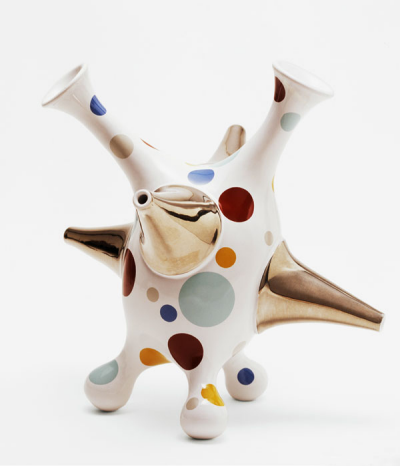
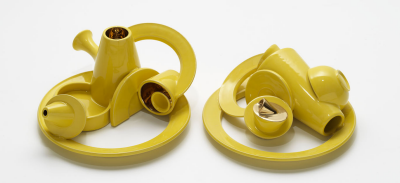
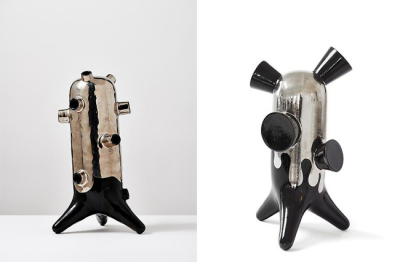
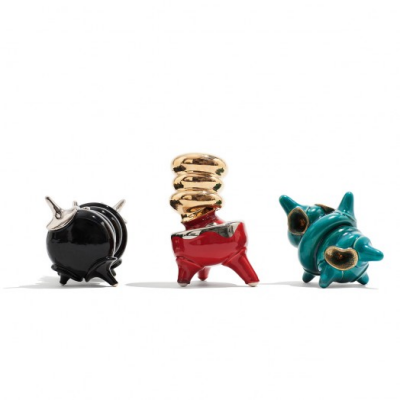
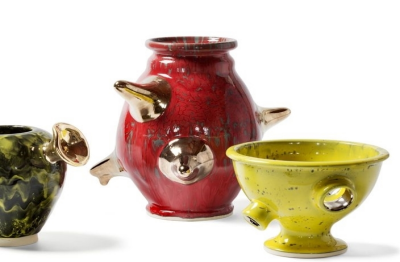
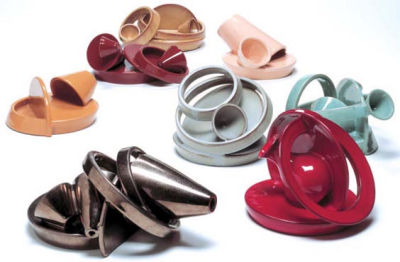
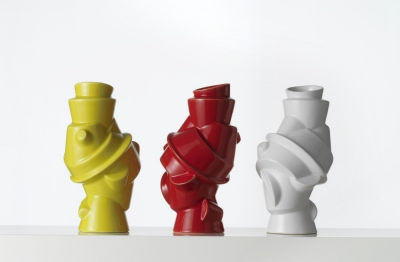
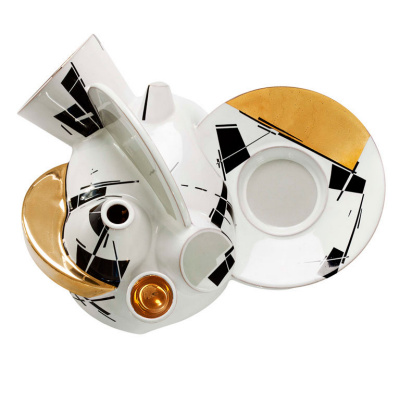
Ãâó : http://www.plusceramics.com/exhibitions/michael-geertsen-2014